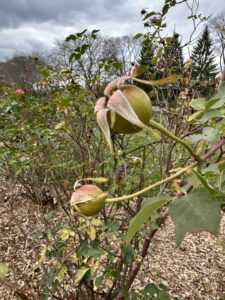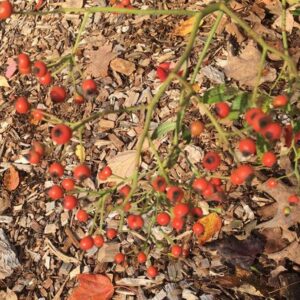You may have noticed what look like orange or red berries on many of the rose bushes throughout the Columbus Park of Roses. These are called “rose hips,” and are the fruits of the rose. They develop as the petals of the rose bloom drop. They begin to appear in late summer and ripen into late autumn after the faded blooms are no longer removed, known as“deadheading.” 
Rose hips typically are red or orange, but they can also be dark purple or black. It has been reported that some roses are grown for the ornamental value of their hips. Rosa macrophylla ‘Master Hugh,’ (pictured) native to the Himalayan region, has the largest hips of any readily available rose. 
It is possible to start rose plants from the seeds found in the rose hips. This might be an interesting experiment for individuals who have roses in their home garden. The seeds must be removed from the rose hip in a way to remove the pulp from the seeds. Pulp prevents sprouting. The seeds should be sterilized and then stratified in order to mimic outdoor weather, following guidelines such as those explained on the Buffalo Niagara Gardening website.
This endeavor would be for the gardener who is patient and enjoys finding unusual results. A new plant may not have the same type and/or color bloom that the original plant produced. Rather, a new plant may look like a pollen donor or a mixture of the parent plants used to produce a particular rose cultivar.
Rose hips are used commercially for a variety of purposes. One such source notes that rose hips have spiritual and health benefits and can be used in love, friendship and peace rituals. They can also be added to potpourri, incense blends and tea. While rose hips are edible, high in Vitamin C and have antioxidant qualities, they must be ingested with caution. They can exacerbate some health issues and conflict with some medications.

Of course, harvesting rose hips, as with any plant material in the Columbus Park of Roses, is prohibited. There wouldn’t be much for the public to enjoy if everyone harvested the garden. Also, because roses are sprayed, it might not be safe to eat rose hips from the garden.
Do take note of rose hips in the late fall and winter as their colors and shapes add visual interest in the subdued gardenscape.
